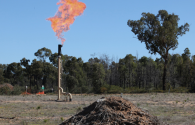At-A-Glance Views

Hydraulic fracturing (or “fracking”) involves injecting wells at high pressure with water, proppants, radioactive tracers and large quantities of chemical additives (including many that are toxic and some with POPs characteristics) to fracture the formation and produce new cracks and pathways to help extract natural gas.
The term 'fracking' refers to hydraulic fracturing, but is now commonly used to describe the process of exploration and production of unconventional gas. Hydraulic fracturing (HF) is a process that involves injecting wells at high pressure with water, proppants, radioactive tracers and large quantities of chemical additives to fracture the formation and produce new cracks and pathways to help extract natural gas.
Fracking is used to extract natural gas in shale formations (‘shale gas’) or gas caught in limestone or sandstone, referred to as ‘tight gas’. HF is also used to retrieve coal bed methane (also known as coal seam gas), once the pressure within the coal seam has reduced and the methane is no longer easily accessible.
Amongst a multitude of other reasons, IPEN is concerned about fracking activities because of the chemical additives used during the process. Out of the 750 chemical products identified by the U.S. House of Representatives Committee on Energy and Commerce as being used in fracking, 650 contain hazardous substances (U.S. House of Representatives Committee on Energy and Commerce, Minority Staff, April 2011, Chemicals Used In Hydraulic Fracturing). These include carcinogens, neurotoxins and endocrine disruptors, including some with POPs characteristics.
Most of these hazardous substances have not been assessed for toxicity or persistence as they relate to the hydraulic fracturing process. Additionally, waste water produced by fracking is contaminated with these hazardous substances as well as other persistent and toxic contaminants, and is reused in numerous processes or released, partially “treated,” into waterways.
For information about toxic chemicals used in unconventional gas exploration and production, please see “Toxic Chemicals in Unconventional Gas Exploration and Production,” developed by National Toxics Network.
Additional related publications produced by National Toxics Network:
- Underground Coal Gasification (UCG) (November 2015)
- Unconventional Gas Exploration and Production: Human Health Impacts and Environmental Legacy (October 2015)
- Hydraulic Fracturing in Coal Seam Gas Mining: The Risks to Our Health, Communities, Environment and Climate (Sept. 2011)
Videos produced by National Toxics Network featuring Dr. Mariann Lloyd-Smith speaking on various aspects of unconventional gas:
- Chemicals, Climate and Unconventional Gas (Lismore, New South Wales, Australia, March 2014)
- Shared Environmental Health Concerns (Ireland, May 2013)
- The Risks of Unconventional Gas and Fracking (Falkirk, Scotland, May 2013)
- Toxic Risks of Coal Seam Gas (Lismore, New South Wales, Australia, March 2012)
Main Right Block
Debug toxic priority variant
